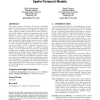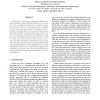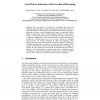88 search results - page 7 / 18 » Assessing the Complexity of Plan Recognition |
GECCO
2005
Springer
14 years 1 months ago
2005
Springer
In this paper we present a genetic algorithm applied to the problem of mission planning for Joint Suppression of Enemy Air Defenses (JSEAD) in support of air strike operations. Th...
WSC
2000
13 years 9 months ago
2000
Circumstance Descriptors are offered as a way to organize spatial and other military knowledge that may be difficult to formulate, particularly the kinds of details that are most ...
ATAL
2006
Springer
13 years 11 months ago
2006
Springer
This paper presents a framework for robustly recognizing physical team behaviors by exploiting spatio-temporal patterns. Agent team behaviors in athletic and military domains typi...
ICPR
2004
IEEE
14 years 8 months ago
2004
IEEE
In this paper, we propose an unsupervised approach to select representative face samples (models) from raw videos and build an appearance-based face recognition system. The approa...
ICCBR
2010
Springer
13 years 11 months ago
2010
Springer
The vast majority of research on AI planning has focused on automated plan recognition, in which a planning agent is provided with a set of inputs that include an initial goal (or ...



